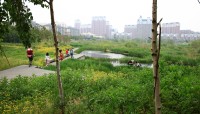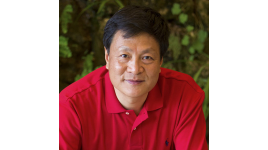Designed by Turenscape in 2009, this approximately 74-acre park is situated in the densely populated Qunli New Town urban district and is an early example of the “sponge city” concept pioneered by firm founder, Kongjian Yu. The park features a former wetland, which was severed from its water sources as the district developed in the early 21st century. Intended to alleviate storm-related flooding, the park fulfills several ecosystem functions, including water retention and filtration, aquifer recharge, and providing wildlife habitat. Employing cut-and-fill techniques, Turenscape sculpted a necklace of ponds and mounds hugging the park’s perimeter, framing its massive central wetland expanse, leaving it open. The park’s outer ring acts as a transitional buffer zone, filtering and cleansing stormwater as it flows from the surrounding urban context towards the central wetland.
Entrances situated along the park’s eastern and western edges connect to a network of pedestrian paths that circumvent the mounds, each of which is populated with dense groves of silver birch trees and planted with native wetland grasses. Simple backless benches and low, rectilinear platforms sited near the water’s edge afford visitors panoramic views, privacy, and immersion in the verdant, natural setting. The scattered mounds are connected by elevated walkways that provide panoramic views to the landscape below and the urban skyline beyond. The walkways lead to viewing platforms and five distinct pavilions that each feature different materials: bamboo, wood, brick, stone, and metal. Two complementary observation towers, that appear as pronounced sculptural objects, are sited opposite one another atop mounds at the eastern and western corners of the park, afford multiple viewing opportunities of the park’s wetland interior. The park was awarded an award of excellence in 2012 by the American Society of Landscape Architects.













